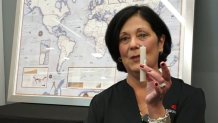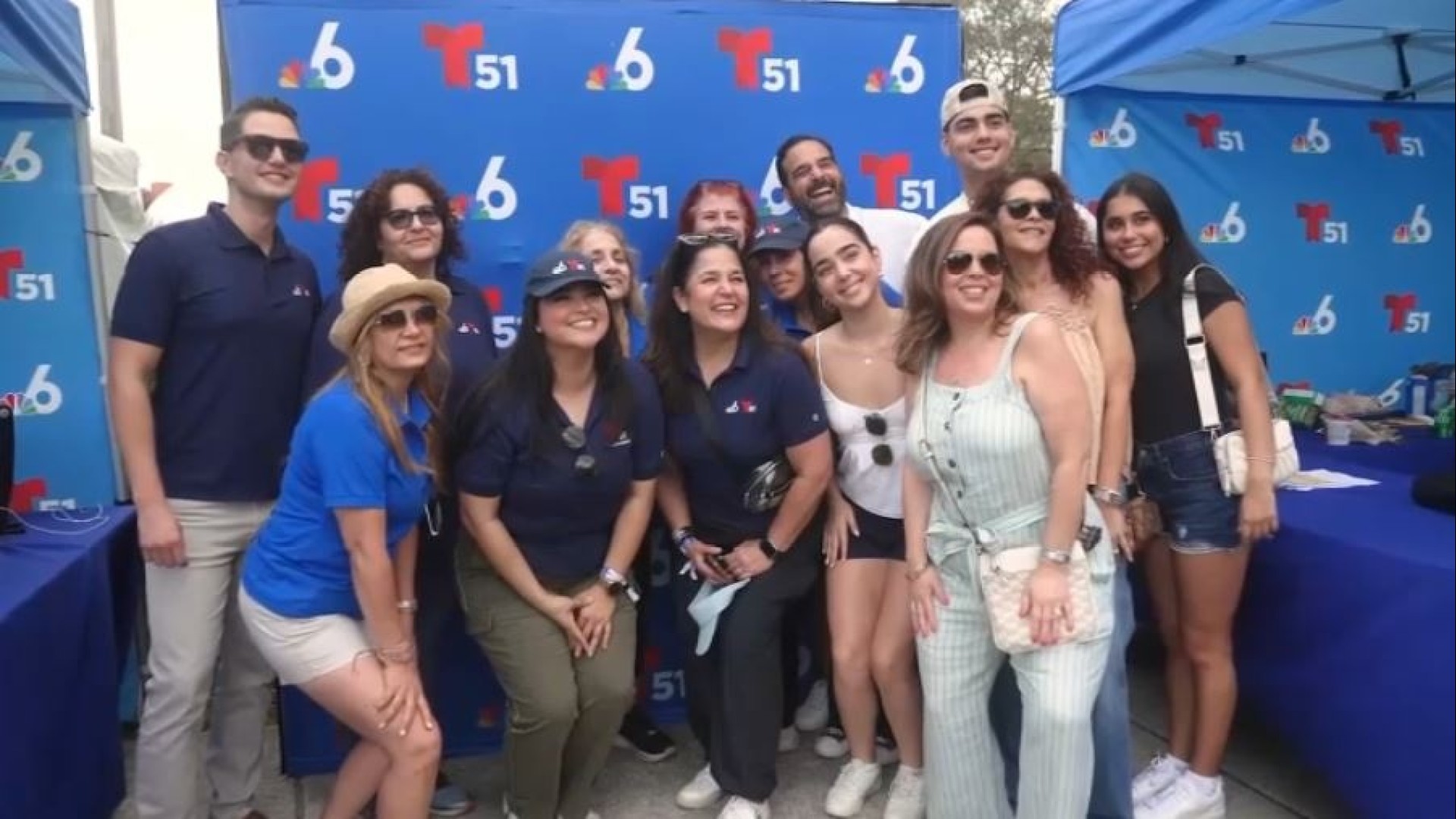Imagine you’re at home working. How does your email send to a client in Brazil?
Imagine you're on your phone shopping. How does your order get confirmed to the clothing company in Spain?
You might not believe it, but those scenarios can happen largely in part because of one building located right in the heart of downtown Miami – one that you may not have noticed before.
NAP of the Americas, or MI-1, is owned by Equinix, the world’s largest digital infrastructure company. The building, which roughly takes up 16 acres of space, has 700,054 square feet of purpose data center floor, with each floor being 120,000 feet.
The Hurricane season is on. Our meteorologists are ready. Sign up for the NBC 6 Weather newsletter to get the latest forecast in your inbox.
“A data center is a building that hosts computers, computers from every type of business and environment, and what we do is we power that ecosystem to grow and connect with each other,” said Grace Padron, the Senior Director of Operations for Equinix’s Miami and Atlanta metros.
The facility is just one of 260 data centers that Equinix operates. The one in Miami, like the others, is working 24/7, 365 days a year.
The Miami site has 45 employees that monitor all of the physical and virtual systems, monitors, servers and routers that house information and help connect more than 800 businesses and corporations.
Local
But this location might be the most important.
It’s the main hub for internet communication to Latin and South America. There are 47,000 square meters of space dedicated to just that in MI1.
And there’s a reason as to why.
Padron said it has to do with our proximity to our southern neighbors.
“Imagine trying to get business, any business into South America, the geography of South America," Padron said. "You have the largest jungle in the world, the Amazon, and one of the tallest mountain ranges, the Andes, so getting terrestrial cables around the geography was very hard.”
But how is Florida able to get around that geography?
The answer is through submarine communication cables, better known as subsea cables.
They look like small tan tubes, with small hairs sticking out.
"This is the bare of the subsea cable, it does get protected a little more, but it’s just very thin fiber strands," Padron said while holding one up.

Those fibers are about the size of a human hair and they send data as quickly as 671 million mph.
According to the U.S. Naval Institute, more than 97% of all internet traffic is connected through a network of subsea cables that are under the ocean.
In Florida, there are currently 17 landing sites, with seven in the works, that connect to other landing sites in countries like Panama, Honduras, Venezuela and Brazil.
The cables connecting the landing sites are thousands of miles long and are operated by different telecommunication companies like Google.
How Equinix fits in, is that the company has provided landing sites. Many of these landing sites are right in their own data centers.
The data center in Miami, NAP of the Americas, has 18 subsea cables coming in.
“In this facility we have eight entry points into this facility, meaning that we can bring the subsea cables that comes from north of us at Dania Beach, through a cable landing station, then now comes in fiber, terrestrial into our facilities,” Padron said, pointing to two large silver tubes coming out of the ground.
Once in the building, the cable is split into other fiber cables and goes into a room called a colocation environment.
“This is where customers come in, we build their cages or cabinets, and this is where they reside,” Padron said.
The customers cages have more cables that travel to a meet point room. It is the place where carriers like AT&T or Verizon get connected to customers from anywhere in the world.
“Meet point rooms is where all customers come and play, literally. They interconnect. We talk about interconnect, which is communication between two points," Padron said. "So, Customer A needs to talk to Customer B. In the old days, it would take months and months to get those facilities brought in.”
“In a location like this, this is why data centers are so important, is the ability to facilitate that for customers," she said. "Now within 24 hours, with one cable you can be connected to anywhere in the world. So just imagine the latency you left behind, just by being in a location like this.”
In MI-1 there are 12 meet point rooms. Right now only 10 are in service.
These spaces are like an international airport. Instead of making layovers at smaller airports, the data center provides non-stop flights for the passage of information from your phone in South Florida, to a phone in Argentina or Colombia.
In essence, the infamous "cloud" lives there.
“Everyone says ‘the cloud’ – well this is 'the cloud,'" Padron said with a laugh. “The cloud is just built of data centers that house servers and routers that route to the entire world, and connect the world and provide that information. Information resides on the cloud, yes on these servers, and for our customers that we protect. We protect by our physical security infrastructure and connect by the ability to provide them pathways to connect very quickly, in simple terms, very quickly, across the world.”
But how does Equinix ensure that the data being shared and operations are secure?
To enter the building, one must pass a security check. Every floor has biometrics to get in and out of every room, security cameras inside and outside the entire facility, as well as internal record-keeping and maintenance on all systems.
There’s also security from natural disasters. MI-1 is one of the eight wonders of the data center world as it’s able to withstand a Category 5 hurricane.
“We have steel reinforced concrete walls. We are designed not to flood outside; We are in a 500-year no-flood zone," Padron said. "We are designed so that water that falls on the roof, down to the base, floods our internal garage, and then we pump that water out."
Even though they haven’t had a major blimp yet, they are prepared for anything.
“In Florida, we’ve got summer rains – our thunderstorms, every day, 3 o’clock, you know they are coming," she said. "We might have a power glitch which for us, having that for our customers is not a good thing. So, we have generators.”
“When we see a millisecond, half a cycle of power drop, our generators kick in," Padron said. "We have 18 generators supporting this facility. And each floor is a separate electrical plant, so customers will never ever go down.”
It’s a well-oiled machine. Its main job is to make sure its customers' cloud, internet connectivity, and digital infrastructure continue to run smoothly.
There are air conditioning handlers to keep motors speeds and temperatures sustained, systems to make sure power is getting distributed correctly, and cages that intake cool air and output hot air to make sure all servers and routers are not overworked.
It’s an intricate system that is expected to keep growing.
On the sixth floor of MI1, construction workers were hard at work.
“We never want to be left behind, because we never want to leave our customers behind," Padron said. "We know after 80% sold we have to start looking at infrastructures, what we are going to need for our customers, and then we prepare for it and we build.”
In February of 2025, Equinix is expecting to have more than 1,000 additional cabinets available for new or existing clients to ensure everyone around the world can continue communicating.
“We allow that connectivity to happen. We maintain our buildings running. Efficiently and securely, so customers feel at ease that their information is always protected, that their business is always protected," Padron said.
Equinix serves every national and international carrier in the world, Padron said. Since 2011, Equinix has invested more than $2.5 billion towards Latin America projects. They say they are currently investing in Brazil, Chile and Mexico.



